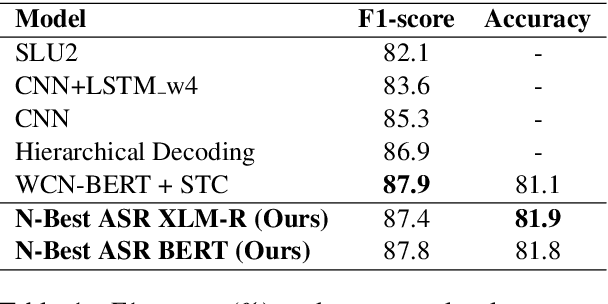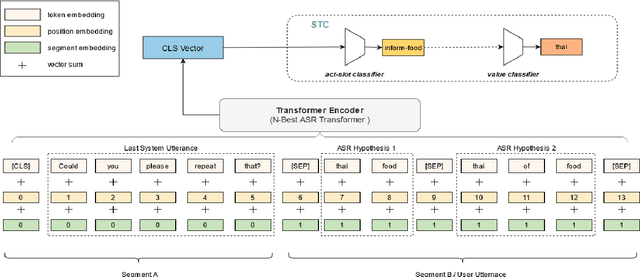Abhinav Tushar
N-Best ASR Transformer: Enhancing SLU Performance using Multiple ASR Hypotheses
Jun 11, 2021



Abstract:Spoken Language Understanding (SLU) systems parse speech into semantic structures like dialog acts and slots. This involves the use of an Automatic Speech Recognizer (ASR) to transcribe speech into multiple text alternatives (hypotheses). Transcription errors, common in ASRs, impact downstream SLU performance negatively. Approaches to mitigate such errors involve using richer information from the ASR, either in form of N-best hypotheses or word-lattices. We hypothesize that transformer models learn better with a simpler utterance representation using the concatenation of the N-best ASR alternatives, where each alternative is separated by a special delimiter [SEP]. In our work, we test our hypothesis by using concatenated N-best ASR alternatives as the input to transformer encoder models, namely BERT and XLM-RoBERTa, and achieve performance equivalent to the prior state-of-the-art model on DSTC2 dataset. We also show that our approach significantly outperforms the prior state-of-the-art when subjected to the low data regime. Additionally, this methodology is accessible to users of third-party ASR APIs which do not provide word-lattice information.
Making Sense of Hidden Layer Information in Deep Networks by Learning Hierarchical Targets
Sep 24, 2016



Abstract:This paper proposes an architecture for deep neural networks with hidden layer branches that learn targets of lower hierarchy than final layer targets. The branches provide a channel for enforcing useful information in hidden layer which helps in attaining better accuracy, both for the final layer and hidden layers. The shared layers modify their weights using the gradients of all cost functions higher than the branching layer. This model provides a flexible inference system with many levels of targets which is modular and can be used efficiently in situations requiring different levels of results according to complexity. This paper applies the idea to a text classification task on 20 Newsgroups data set with two level of hierarchical targets and a comparison is made with training without the use of hidden layer branches.
Comparing Writing Styles using Word Embedding and Dynamic Time Warping
Nov 05, 2015



Abstract:The development of plot or story in novels is reflected in the content and the words used. The flow of sentiments, which is one aspect of writing style, can be quantified by analyzing the flow of words. This study explores literary works as signals in word embedding space and tries to compare writing styles of popular classic novels using dynamic time warping.
 Add to Chrome
Add to Chrome Add to Firefox
Add to Firefox Add to Edge
Add to Edge